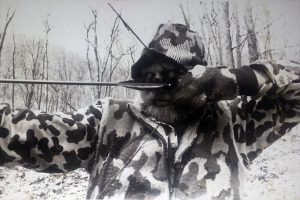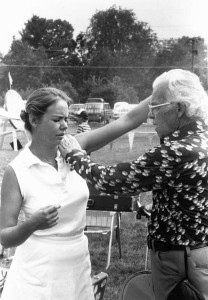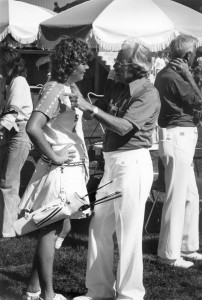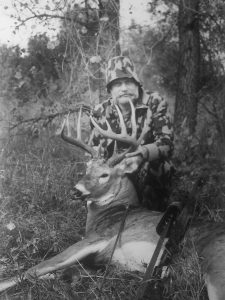(this article is excerpted from UNDERSTANDING WINNING ARCHERY, by Olympic Archery Coach Al Henderson)

• No matter how or where you anchor, with fingers or release, compound or stick bow, keep your bow arm solid and unmoving through the aim and the shot, and you’ll do well. A solid bow arm unit forgives other minor form and release errors.
When you’re shooting from an elevated stand, bend at the waist. Keep your bow arm at the same angle from your body as if you were standing on the ground. DO NOT drop your bow arm; doing so changes all sorts of things, beginning with your draw length.
What one thing in shooting style or method, what one phase of the shooting form, is the most important? This is most often asked by a competitive shooter, but it applies to anyone shooting an arrow anywhere at anything. (Think whitetail deer. Think a 10-point rack on a somewhat suspicious buck at 20 yards. Think self-imposed tension.)
I believe that what happens to the ‘bow arm unit’ in that precise span of time between the instant of the brain command and the time the arrow clears the bowstring is the key to a successful shot.
This is the last ingredient added to the recipe for god scores and hunting shots that hit the little spot you picked as your aiming point. Whatever happens at the exact instant that our brain gives the message to string fingers to relax their hold on the string or the string hand to trip the release is the thing that makes everything else we have put together for that shot produce either the results we are expecting or the result we did not want.
The tragic thing about this often unrecognized fact is that a coach cannot really see it happen, and a student/shooter does not exactly feel it or, for that matter, even believe it. Buddy, it’s there, big as life, and it can be proven.
Any reference to a measure of time or speed that may be used in this article is for comparison only. It takes the brain 70 milliseconds to give any part of our body a command. Therefore, brain has time to give us more than 14 commands in one second. It probably does, too, since we can stand without falling, breathe, walk, talk, smile, close our eyes and unlock the car door at the same time.
A shooter can use this knowledge to his/her advantage.
In shooting, the little, almost unnoticeable cause of an almost-but-not-quite-perfect shot could be that at the exact moment the brain commands the release of the string, a small movement (even the tightening of an arm or shoulder muscle from unnecessary tension) in his bow arm unit, for any reason whatsoever, louses up his shot. If any part of this bow arm unit moves only one thirty-second of an inch, before the impact of the release-and-shot ‘explosion’ hits the shooter, it can put the arrow somewhere other than dead center. This error of movement is also magnified because the unit continues moving all through the explosion, like a shotgun moves when shooting a bird in flight. It is a small amount and it will vary for many reasons depending on what caused it. But bow arm movement wrecks things.

• Olympic archery coach Al Henderson working with a student, setting the bow shoulder, visualizing how it should feel.
When the brain gives the command for the fingers to relax, every part of the body knows that command has been given and that this is the beginning of the end of the effort. This is the most important moment.
As an example, at the instant the command is given, the shoulder could slightly quit holding its position because it anticipates that the shot will soon be over. The elbow could anticipate the finish and not stay rigid. The wrist could do the same thing. The bow arm must hold the physical weight of the bow after the explosion so it can begin to get ready at the instant of command, without waiting for the weight to manifest itself. The entire arm unit could decide that the show is over at the moment the command is given to the fingers to release, and begin to relax because its work is soon over. The concentration of aiming could also start to give up and quit working too soon. And on and on.

• Olympic archery coach Al Henderson making a point with 1976 Olympic gold medalist Luann Ryan.
What other single thing in the whole scheme of shooting technique is so dependent upon so many other things to make it work? I can think of nothing that has so many operations dictating the success or failure of the shot as does the one-thousandth of a second of time between the brain command and the bowstring being released. This is the most important instant of all. This is the time in which you must exercise the control necessary to hold still – to keep your bow arm unit still — until the shock of explosion hits.
I agree, 100 percent control is all you need. That would solve everything. However, unless you know what the problem is and understand its importance, you don’t generally control down to the fine points that we are talking about here.
Keeping the bow arm unit still is part of follow-through. Follow-through is the continuation of your form as it was before the explosion. Think this through thoroughly and shoot better.
- This how-to tip is excerpted from UNDERSTANDING WINNING ARCHERY, a 122-page how-to book by Al Henderson. Al Henderson was coach of the 1976 U.S. Olympic archery team that won gold medals in men’s and women’s competition. More than 200 of his students won state, regional or national championships. Many were members of college All-American archery teams; others were members of the U.S. Olympic archery team and World Championship team. He was inducted into the U.S. Archery Hall of Fame in 1982.


